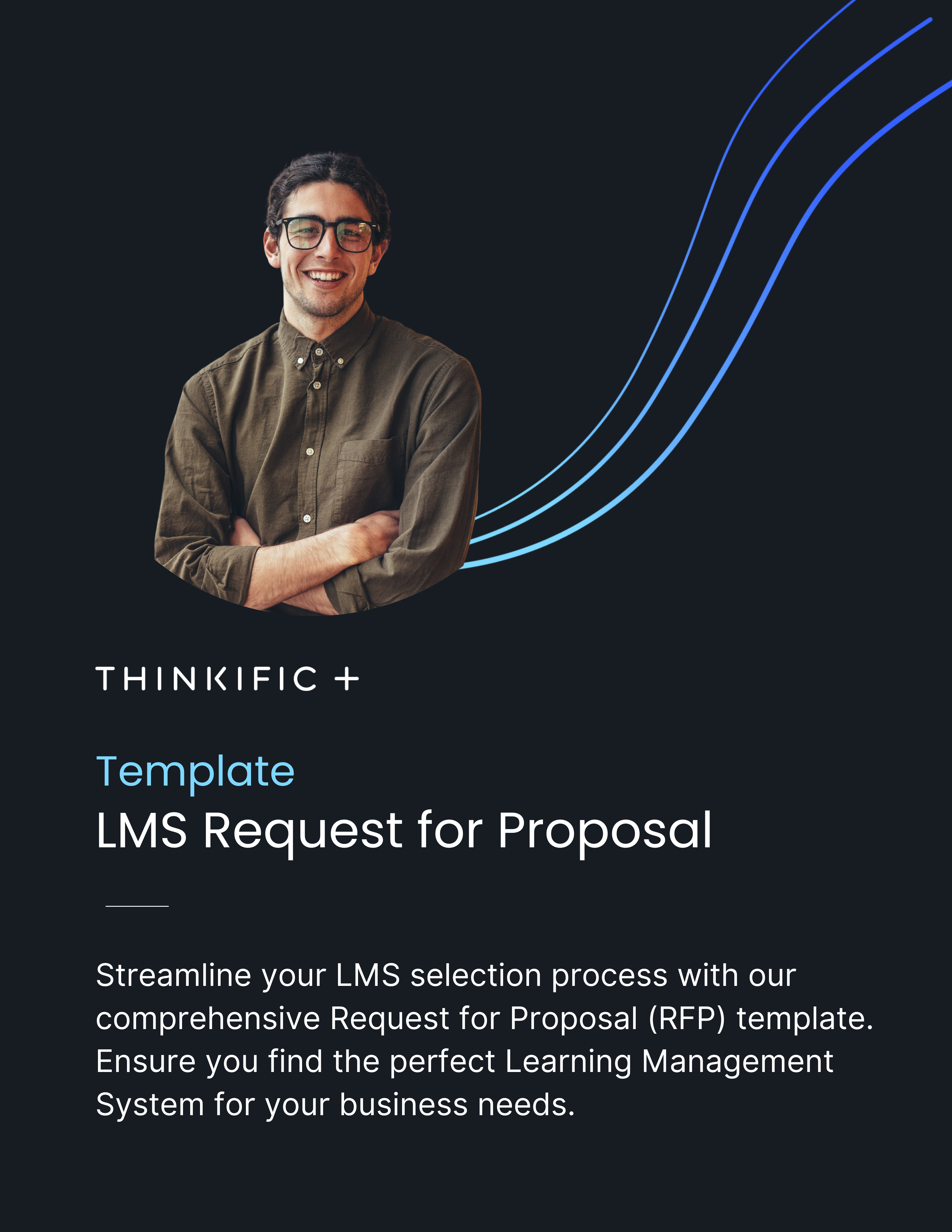Navigating the technology and education space can be overwhelming, and finding the right learning management system (LMS) for your organization is an important but intimidating task. Don’t worry; the RMS LFP template is here to help.
A Request for Proposal (RFP) is a structured document that acts as a bridge to vendors, leading to the ideal solution. An accurate and detailed RFP gives organizations the best chance of selecting the best LMS.
Crafting the perfect RFP is an art, and that’s where an LMS RFP template comes to the rescue. A comprehensive template facilitates a clear exchange of information, reducing misunderstandings and opening the door to cost-effective solutions.
Think of the template as the roadmap that guides you to your destination. Embrace the journey to find the ideal LMS that fits your organization’s unique needs. Harness the power of a well-crafted RFP template and let it take the wheel!
Start now and elevate your organization to greater heights.
Skip ahead:
- What is an LMS RFP and Why You Need One
- Key Components of an LMS RFP Template
- Tips for Crafting a Winning LMS RFP
- Download Our Comprehensive LMS RFP Template
- Frequently Asked Questions
What is an LMS RFP and Why You Need One
An LMS RFP, or learning management system request for proposal, is more than just an industry acronym. It’s a pivotal tool in the educational and corporate worlds that shapes how we learn, train, and grow.
An organization creates an LMS RFP to solicit bids from potential vendors. The document outlines specific needs, requirements, and criteria, focusing primarily on LMSs that handle the administration, tracking, and delivery of educational courses or training programs.
It’s like sending out a carefully detailed wish list to potential suppliers, expecting them to return with their best-fitting solutions. The eLearning RFP serves a multi-fold purpose. Here’s why it’s essential:
Clarity
A proposal lets an organization clearly articulate its needs, goals, and expectations. By using an LMS RFP template, a company can ensure that all the essential points are covered systematically.
Comparison
With every vendor responding to the same criteria set, comparing their offerings on a like-for-like basis becomes simpler. It’s akin to having different chefs prepare the same dish, allowing you to taste and pick the best.
Cost-Effectiveness
The learning management system RFP’s transparency helps negotiate a fair price, ensuring you pay for what you need and not for unnecessary add-ons.
Strategic Alignment
Organizing your needs into one document ensures that the selected LMS aligns with organizational goals, both present and future, like fitting pieces of a puzzle together.
Risk Management
Detailing all aspects of the required solution minimizes misunderstandings and risk, creating a solid foundation for a long-term vendor-client relationship.
The LMS RFP isn’t just a document; it’s a strategic map guiding you through the intricate maze of the eLearning system selection process, and will provide many benefits for both you and your prospective vendors. Here are a few:
- Understanding Needs: A comprehensive proposal helps an organization understand and detail its unique requirements, like looking at a reflection of its learning needs in a mirror.
- Engaging Vendors: An eLearning proposal is a calling card to potential vendors, inviting them to offer their solutions, igniting a process akin to a professional dance where both parties seek perfect synchronization.
- Ensuring Alignment: By providing a roadmap for vendors to follow, an RFP ensures that they tailor their offerings to meet your needs, cutting through the clutter of generic solutions.
- Final Selection: Ultimately, the LMS RFP acts as a yardstick, a measuring tool to evaluate proposals and choose the one that fits like a glove.
As you can see, creating and using an LMS RFP is not just a procedural necessity; it’s a strategic asset. Whether enhancing employee training or revolutionizing the learning experience in your institution, using an RMS LFP template will guide you to the perfect match.
Key Components of an LMS RFP Template
A thorough LMS RFP template streamlines the procurement process for a learning management system, ensuring that specific needs are communicated to vendors. It should include features like:
Project Overview
The LMS RFP begins by outlining the purpose and objectives of the project. Whether aimed at improving employee training or enhancing reporting, a clear statement of purpose ensures alignment with the organization’s needs.
The project timeline, including key milestones and deadlines, is vital for managing expectations and coordinating efforts. Identifying the key stakeholders, from project managers to end-users, fosters collaboration and informed decision-making throughout the process.
Organizational Background
Providing an organizational background offers critical insights about the company, such as mission, size, industry, and target users of the LMS. This information helps vendors customize the LMS solution to meet users’ needs.
It’s also important to give insights into existing systems and tools so vendors can propose integrations to ensure the new LMS is compatible with the organization’s infrastructure.
LMS Requirements
Creating an effective learning management system request for proposal requires including the necessary components to fit your organizational needs. Technical and functional requirements to consider are:
Technical requirements:
- Compatibility with existing tools
- Control browser access
- Mobile responsiveness
Functional requirements:
- User accessibility
- Content management
- Reporting capabilities
- Customization options
- Integration with existing systems
You can find the LMS vendor that best meets your desired objectives and aims by laying out these requirements.
Vendor Qualifications and Experience
The LMS template section examining potential vendors provides comprehensive guidance for assessing background and expertise. Investigate the company’s history, including:
- Years in the business
- Industry recognition
- LMS specialist knowledge
Don’t forget to examine client references and case studies for evidence of successful delivery, meeting deadlines, and ongoing support. All this helps build credibility and confidence in making decisions that align with company goals. It’s imperative you check for a vendor that understands your needs and provides an LMS solution tailored to your vision.
Pricing and Budget
When outlining the cost of an LMS solution, clear transparency is essential to make an informed decision. Request proposals must demonstrate the pricing model, structure, licensing fees, flexibility, and scalability.
Additional fees such as implementation, training, support, and maintenance should also be listed upfront. This ensures no unexpected costs arise and organizations know their budget and expectations.
Knowing the pricing model and extra costs from the start ensures organizations can plan and avoid any unwelcome surprises.
Proposal Submission and Evaluation
Submitting a compelling proposal for an LMS requires clear guidance and a structured evaluation process. Here’s how to achieve success in this critical stage:
Proposal Submission Guidelines
Your proposal must adhere to the specific requirements detailed in the RFP. This includes following the exact format, submitting within the set timeframe, and meeting all specified criteria. Make sure to review the template for the comprehensive guidelines.
Evaluation Criteria
Evaluation will be conducted based on various aspects, including compliance with RFP requirements, LMS features and functionality, vendor’s experience and expertise, client references and case studies, and overall value. Each factor plays a vital role in determining the proposal’s suitability.
Timeline for Vendor Selection
Time management is crucial in the proposal evaluation stage. From the issuance of the RFP to the vendor selection, a well-defined timeline ensures that every phase is completed precisely and efficiently.
By following these guidelines and referring to the provided LMS RFP template, vendors can ensure a well-organized submission, increasing their chances of being chosen. This process also enables the issuing company to find a solution that aligns perfectly with its needs and budget.
Tips for Crafting a Winning LMS RFP
The challenge to designing a suitable LMS proposal lies in conveying your precise needs while leaving room for vendors to bring their creativity and expertise to the table. Using the template provided and considering these crucial points can help ensure you’ll get the outcomes you seek:
Clearly Define Your Organization’s Needs
Start by pinpointing what you require from an LMS. Detailing your organization’s goals, target audience, and current tools and systems will provide vendors with the necessary context. Utilize the information provided under the sections “Project Overview” and “Organizational Background” in the template to guide you through this process.
Prioritize Must-Have Features and Functionality
Within the LMS Requirements section, outline the technical and functional requirements that are essential for your organization. Determine what is non-negotiable and what can be adjusted or added as optional extras and communicate that.
Be Concise and Specific in Your Requirements
While explaining your needs, ensure that your requirements are specific and to the point. The template’s “LMS Requirements” section helps categorize what you need from the system. Being concise helps vendors quickly grasp what you’re looking for, saving both parties time.
Allow Flexibility for Vendor Creativity and Innovation
While it’s essential to identify your specific needs, remember to leave space for vendors to propose innovative solutions that you might have yet to consider. Emphasize this within the “Vendor Qualifications and Experience” section, inviting vendors to share their unique approaches and case studies that align with your needs.
Consider Pricing and Budget Constraints
Clearly outline your budget, including potential additional costs like implementation and support, as defined in the “Pricing and Budget” section. This clarity helps vendors tailor their proposals to meet your financial constraints.
Follow Proposal Submission Guidelines
Adhering to the submission guidelines, as detailed under “Proposal Submission and Evaluation,” ensures that your RFP complies with all the necessary standards and timelines. This adherence is critical to make the evaluation process smooth and fair.
By paying attention to these areas and using the provided template as your guide, you’re on your way to crafting an LMS RFP tailored to your needs and attractive to the best vendors in the market.
Download Our Comprehensive LMS RFP Template
Searching for an LMS doesn’t have to be complicated. Thinkific takes the guesswork out of the process – we’ve created a user-friendly RFP template to help you land the perfect LMS for the job. Our template is designed for easy use and takes you step-by-step through the process.
By filling in your specific details, the right LMS could be just a few clicks away. With Thinkific, you can now give yourself the best chance of getting the best solution for your business.
Download the Thinkific LMS RFP Template and start your journey to the perfect LMS!
Frequently Asked Questions
What is an LMS RFP?
An LMS RFP, or learning management system request for proposal, is a structured document organizations use to solicit bids from potential vendors for an LMS. It outlines specific needs, requirements, and criteria, focusing on platforms that handle the administration, tracking, and delivery of educational courses or training programs.
The purpose of an LMS RFP for selecting your management system is to provide a detailed wish list to potential suppliers, expecting them to return with their best-fitting solutions. It is a strategic tool that helps compare vendors on a like-for-like basis, negotiate a fair price, ensure alignment with organizational goals, and manage risks, ultimately guiding the organization to the perfect LMS match.
How do I create an effective LMS RFP?
Creating an effective LMS RFP requires a comprehensive approach. First, map out your goals and objectives, from improving employee training to enhancing reporting.
Next, use a thorough template that provides vital components such as project overview, organizational background, LMS requirements, vendor qualifications, pricing, and budget. Prioritize must-have features while still leaving room for vendor creativity. Clearly define a budget and adhere to submission guidelines.
Lastly, use a step-by-step template as your guide to tailor the RFP to your needs, ensuring that it appeals to the best vendors. Following these tips can create a well-structured and comprehensive LMS RFP.
How do I evaluate and compare vendor proposals?
Evaluate and compare vendor proposals strategically. Set clear criteria that align with your needs, such as RFP compliance, features and functionality, and vendor experience. Utilize a structured process in your RFP and compare like-for-like proposals to understand how vendors meet your prerequisites.
Consider timelines, references, and case studies to understand each vendor’s capability. Don’t forget to examine the pricing model and structure, including potential extra costs, to understand the financial implications. With an informed approach, you can select a solution that meets your needs and budget.
What are common mistakes to avoid when crafting an LMS RFP?
Common mistakes to avoid when crafting an LMS RFP include needing more clarity, ignoring stakeholder input, overemphasizing cost, ignoring compliance and security, not defining criteria, and not allowing sufficient response time.
Ensure your RFP is specific and detailed with no vague language. Collaborate with all parties involved, such as end-users and IT professionals. Balance cost considerations with other factors like functionality and support and focus on essential functionalities.
Outline legal, regulatory, and security requirements clearly. Define evaluation metrics and provide information on timelines, support, and training. Finally, give vendors ample time to respond to the RFP thoughtfully.
Being mindful of these mistakes will help you create an effective RFP that best meets your organization’s needs.
How can an LMS RFP template help streamline the selection process?
An LMS RFP template can help streamline the selection process by providing some crucial structure. By using a template, organizations have a ready-to-use format and can ensure they include essential components without risking overlooking key details.
It also saves time, can foster collaboration, and facilitates clear communication with vendors for more efficient responses. Ultimately, an LMS RFP template simplifies the process of defining and communicating needs, ensuring the best LMS fit for the organization can be selected quickly and confidently.







